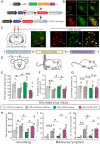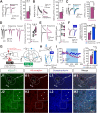Targeting presynaptic H3 heteroreceptor in nucleus accumbens to improve anxiety and obsessive-compulsive-like behaviors
- PMID: 33257584
- PMCID: PMC7749329
- DOI: 10.1073/pnas.2008456117
Targeting presynaptic H3 heteroreceptor in nucleus accumbens to improve anxiety and obsessive-compulsive-like behaviors
Abstract
Anxiety commonly co-occurs with obsessive-compulsive disorder (OCD). Both of them are closely related to stress. However, the shared neurobiological substrates and therapeutic targets remain unclear. Here we report an amelioration of both anxiety and OCD via the histamine presynaptic H3 heteroreceptor on glutamatergic afferent terminals from the prelimbic prefrontal cortex (PrL) to the nucleus accumbens (NAc) core, a vital node in the limbic loop. The NAc core receives direct hypothalamic histaminergic projections, and optogenetic activation of hypothalamic NAc core histaminergic afferents selectively suppresses glutamatergic rather than GABAergic synaptic transmission in the NAc core via the H3 receptor and thus produces an anxiolytic effect and improves anxiety- and obsessive-compulsive-like behaviors induced by restraint stress. Although the H3 receptor is expressed in glutamatergic afferent terminals from the PrL, basolateral amygdala (BLA), and ventral hippocampus (vHipp), rather than the thalamus, only the PrL- and not BLA- and vHipp-NAc core glutamatergic pathways among the glutamatergic afferent inputs to the NAc core is responsible for co-occurrence of anxiety- and obsessive-compulsive-like behaviors. Furthermore, activation of the H3 receptor ameliorates anxiety and obsessive-compulsive-like behaviors induced by optogenetic excitation of the PrL-NAc glutamatergic afferents. These results demonstrate a common mechanism regulating anxiety- and obsessive-compulsive-like behaviors and provide insight into the clinical treatment strategy for OCD with comorbid anxiety by targeting the histamine H3 receptor in the NAc core.
Keywords: OCD; anxiety; histamine H3 receptor; nucleus accumbens; prelimbic prefrontal cortex.
Copyright © 2020 the Author(s). Published by PNAS.
Conflict of interest statement
The authors declare no competing interest.
Figures





Similar articles
-
Excitatory Projections from the Prefrontal Cortex to Nucleus Accumbens Core D1-MSNs and κ Opioid Receptor Modulate Itch-Related Scratching Behaviors.J Neurosci. 2023 Feb 22;43(8):1334-1347. doi: 10.1523/JNEUROSCI.1359-22.2023. Epub 2023 Jan 18. J Neurosci. 2023. PMID: 36653189 Free PMC article.
-
Suppression of excitatory synaptic transmission in the centrolateral amygdala via presynaptic histamine H3 heteroreceptors.J Physiol. 2024 Jul 2. doi: 10.1113/JP286392. Online ahead of print. J Physiol. 2024. PMID: 38953534
-
Histamine H3 Receptor Function Biases Excitatory Gain in the Nucleus Accumbens.Biol Psychiatry. 2021 Mar 15;89(6):588-599. doi: 10.1016/j.biopsych.2020.07.023. Epub 2020 Aug 6. Biol Psychiatry. 2021. PMID: 33012522 Free PMC article.
-
Anatomic Review of the Ventral Capsule/Ventral Striatum and the Nucleus Accumbens to Guide Target Selection for Deep Brain Stimulation for Obsessive-Compulsive Disorder.World Neurosurg. 2019 Jun;126:1-10. doi: 10.1016/j.wneu.2019.01.254. Epub 2019 Feb 18. World Neurosurg. 2019. PMID: 30790738 Review.
-
Animal models of obsessive-compulsive disorder: rationale to understanding psychobiology and pharmacology.Psychiatr Clin North Am. 2006 Jun;29(2):371-90. doi: 10.1016/j.psc.2006.02.007. Psychiatr Clin North Am. 2006. PMID: 16650714 Review.
Cited by
-
Histaminergic System Activity in the Central Nervous System: The Role in Neurodevelopmental and Neurodegenerative Disorders.Int J Mol Sci. 2024 Sep 12;25(18):9859. doi: 10.3390/ijms25189859. Int J Mol Sci. 2024. PMID: 39337347 Free PMC article. Review.
-
Excitatory Projections from the Prefrontal Cortex to Nucleus Accumbens Core D1-MSNs and κ Opioid Receptor Modulate Itch-Related Scratching Behaviors.J Neurosci. 2023 Feb 22;43(8):1334-1347. doi: 10.1523/JNEUROSCI.1359-22.2023. Epub 2023 Jan 18. J Neurosci. 2023. PMID: 36653189 Free PMC article.
-
Chemogenetic activation or inhibition of histaminergic neurons bidirectionally modulates recognition memory formation and retrieval in male and female mice.Sci Rep. 2024 May 17;14(1):11283. doi: 10.1038/s41598-024-61998-0. Sci Rep. 2024. PMID: 38760416 Free PMC article.
-
Recovery of the histamine H3 receptor activity lost in yeast cells through error-prone PCR and in vivo selection.Sci Rep. 2023 Sep 26;13(1):16127. doi: 10.1038/s41598-023-43389-z. Sci Rep. 2023. PMID: 37752220 Free PMC article.
-
Mechanisms of nucleus accumbens deep brain stimulation in treating mental disorders.Fundam Res. 2024 Jul 6;5(1):48-54. doi: 10.1016/j.fmre.2024.06.009. eCollection 2025 Jan. Fundam Res. 2024. PMID: 40166085 Free PMC article. Review.
References
-
- Grant J. E., Clinical practice: Obsessive-compulsive disorder. N. Engl. J. Med. 371, 646–653 (2014). - PubMed
-
- de Vries F. E., et al. , Compensatory frontoparietal activity during working memory: An endophenotype of obsessive-compulsive disorder. Biol. Psychiatry 76, 878–887 (2014). - PubMed
-
- Gunaydin L. A., Kreitzer A. C., Cortico-basal ganglia circuit function in psychiatric disease. Annu. Rev. Physiol. 78, 327–350 (2016). - PubMed
Publication types
MeSH terms
Substances
LinkOut - more resources
Full Text Sources
Other Literature Sources
Medical

